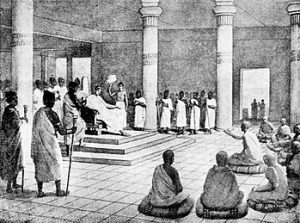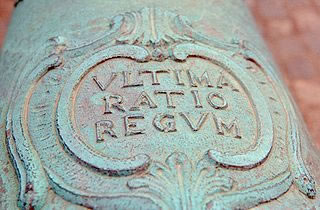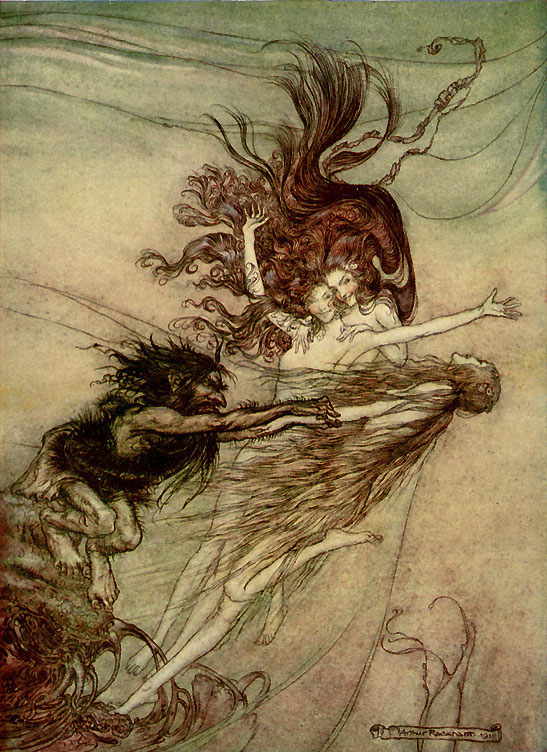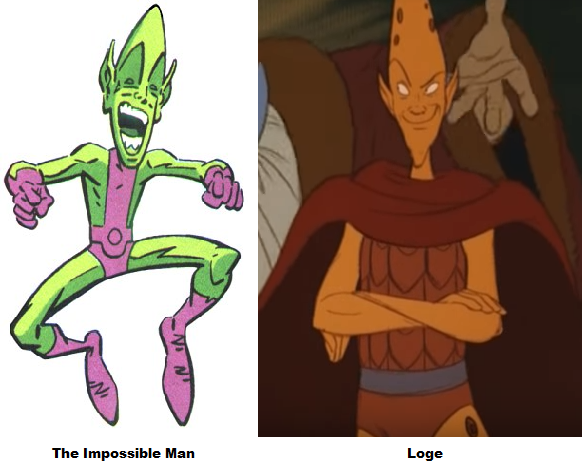
Or, if you prefer Gaiman’s version to Marvel’s:


Or, if you prefer Gaiman’s version to Marvel’s:


KING MILINDA: Reverend Sir, will you discuss with me again?
NAGASENA: If your Majesty will discuss as a scholar, well; but if you will discuss as a king, no.
KING MILINDA: How is it then that scholars discuss?
NAGASENA: When scholars talk a matter over one with another then is there a winding up, an unravelling; one or other is convicted of error , and he then acknowledges his mistake; distinctions are drawn, and contra-distinctions; and yet thereby they are not angered. Thus do scholars, O king, discuss.
KING MILINDA: And how do kings discuss?’
NAGASENA: When a king, your Majesty, discusses a matter, and he advances a point, if any one differ from him on that point, he is apt to fine him, saying: “Inflict such and such a punishment upon that fellow!” Thus, your Majesty, do kings discuss.
— Milindapañha (Buddhist text, 1st c. BCE-2nd c. CE)

There is a way of managing an Argument … which is made use of by States and Communities, when they draw up a hundred thousand Disputants on each Side, and convince one another by Dint of Sword. A certain Grand Monarch was so sensible of his Strength in this way of Reasoning, that he writ upon his Great Guns – Ratio ultima Regum, The Logick of Kings ….
When one has to do with a Philosopher of this kind, one should remember the old Gentleman’s Saying, who had been engaged in an Argument with one of the Roman Emperors. Upon his Friends telling him, That he wonder’d he would give up the Question, when he had visibly the Better of the Dispute; I am never asham’d, says he, to be confuted by one who is Master of fifty Legions. …
But the most notable way of managing a Controversy, is that which we may call Arguing by Torture …. Men were formerly disputed out of their Doubts, reconciled to Truth by Force of Reason, and won over to Opinions by the Candour, Sense and Ingenuity of those who had the Right on their Side; but this Method of Conviction operated too slowly. Pain was found to be much more enlightening than Reason. Every Scruple was looked upon as Obstinacy, and not to be removed but by several Engines invented for that Purpose. In a Word, the Application of Whips, Racks, Gibbets, Gallies, Dungeons, Fire and Faggot, in a Dispute, may be look’d upon as Popish Refinements upon the old Heathen Logick.
— Joseph Addison, Spectator 239 (4 Dec. 1711)

In the original Norse myths, Thor disguises himself as a woman, specifically a bride, in order to sneak into the giants’ fortress.
Still more radically, in order to lure a male horse away from its owner, Loki transforms himself into a female horse in heat, allows himself to be impregnated, and subsequently gives birth to a magical horse.
In the Nibelungenlied, Brünnhilde is physically stronger than any man, and can be defeated only by magical trickery.
Just a reminder, for those complaining that Marvel is ruining the macho purity of Norse mythology.
In yesterday’s installment, Das Rheingold, the result of the giants’ abducting Freya with her apples of youth is that old age begins to fall upon the Asgardian gods, and cannot be reversed until she is returned. (Wagner is here mashing together two different legends, that of Freya’s betrothal to the giant with that of Loki’s abduction of Idunn with her apples of youth.) Likewise in the Greek myth of “Persephone” (2002; “Animated Tales of the World”) the result of the god of the underworld’s abducting the daughter of the goddess of fertility is that winter falls upon the world, and likewise cannot be reversed until she is returned.
This version of the story incidentally makes Persephone rather more cheerful about her abduction than she is in the original myth, where she refrained from eating as long as possible in order not to be trapped in Hades’ realm, and succumbed to eating the pomegranate seeds only out of hunger.
One Ring for the Dwarf Lord in his hall of stone ….
As different as they seem, Oberon/Auberon, the king of the fairies in British and French folklore (and thus in Shakespeare’s Midsummer Night’s Dream), originates as a variation on Alberich, the dwarf king of Germanic folklore, whom Richard Wagner in turn combined with the Icelandic dwarf Andvari in his operatic mashup of Germanic and Icelandic versions of Norse mythology together with the Rhinemaiden legend, the Hesperides legend, and Feuerbachian and Schopenhauerian philosophy, in his Ring Cycle which kicks off with Das Rheingold, here adapted in 1995 as part of the “Operavox” series:
The visual portrayal of the Rhinemaidens may be influenced by Arthur Rackham’s:

Freya, by contrast, looks as though she stepped out of a 1970s sword-and-sorcery comic:

And Loge (Wagner’s mash-up of Loki the trickster-god with Logi the fire-god) strongly resembles the Marvel Comics trickster character, the Impossible Man:

The location of A Midsummer Night’s Dream (from “Shakespeare: The Animated Tales,” 1992) is purportedly ancient Greece (specifically Athens, during the preparations for the wedding of Theseus and Hippolyta), but the fairies who populate the nearby woods are all drawn from the Celtic and Germanic folklore of northern Europe, which makes this a natural segue from the tale of Fionn mac Cumhaill; and the hostility between the estranged king and queen of the fairies and their struggle for control over the Indian prince resembles the hostility between Mozart’s Sarastro and the Queen of the Night, and their struggle for control over Pamina, from before that.
The artistic style for this one reminds me a bit of Gahan Wilson.
| M | T | W | T | F | S | S |
|---|---|---|---|---|---|---|
| 1 | 2 | 3 | 4 | 5 | 6 | |
| 7 | 8 | 9 | 10 | 11 | 12 | 13 |
| 14 | 15 | 16 | 17 | 18 | 19 | 20 |
| 21 | 22 | 23 | 24 | 25 | 26 | 27 |
| 28 | 29 | 30 | 31 | |||